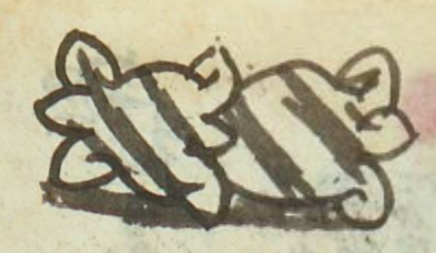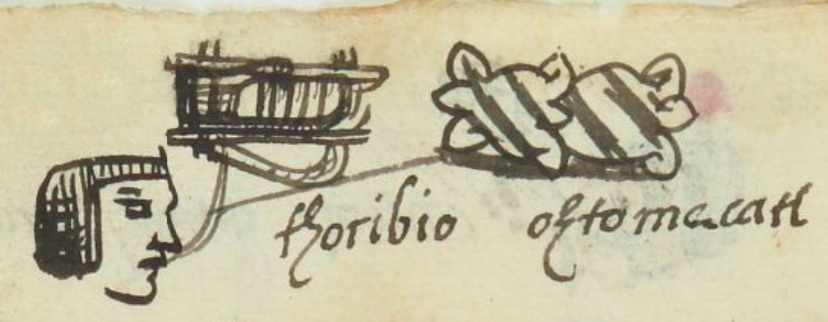Oztomecatl (MH487v)
This black-line drawing of the simplex glyph for the personal name, ethnicity, and occupation, Oztomecatl (“Vanguard Merchant” or “Person from Oztoman,” attested here as pertaining to a man) shows two stones in a horizontal row. They have curling ends and black and white stripes. Perhaps these stones have some association with a cave (oztotl). The term oztomecatl refers to a long-distant merchant who traveled in the vanguard in the expansion of empire. These merchants seem to have come from Oztoman originally.
Stephanie Wood
The Oztomeca were known as merchants who kept secrets and hid things. [See Samuel Salinas Álvarez, Historia de los caminos de Mexico, t. 1 (1994), 88.] The contextualizing image shows that this person used carrying frames as a part of his long-distance trade.
This Nahua name-ethnicity-occupation is preceded in the gloss by a Christian first name (Toribio). He may have been named after Toribio de Benavente, also known as Motolinia ("One Who is Poor or Afflicted"). This was believed to be the first word the friar learned in Nahuatl, and he went on to learn the language well. He lived in the monastery in Huejotzingo. Doing a quick search for the name "Toribio" will produce an impressive result.
Stephanie Wood
thoribio oztomecatl
Toribio Oztomecatl
Stephanie Wood
1560

oztomeca(tl), a long-distance merchant or someone from Oztoman, https://nahuatl.wired-humanities.org/content/oztomecatl
ozto(tl), cave, https://nahuatl.wired-humanities.org/content/oztotl
Cueva-Cordón, o Útero y ombligo(?)
Stephanie Wood
Matrícula de Huexotzinco, folio 487v, World Digital Library, https://www.loc.gov/resource/gdcwdl.wdl_15282/?sp=53&st=image.
This manuscript is hosted by the Library of Congress and the World Digital Library; used here with the Creative Commons, “Attribution-NonCommercial-ShareAlike 3.0 License” (CC-BY-NC-SAq 3.0).








